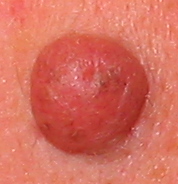Up till now, finding out if a mole is a potentially life-threatening melanoma has been a complex task, resulting in both under- and over diagnosis. However, a novel diagnostic staining test has been designed, developed and studied by investigators at Weill Medical College. According to the researchers, the test can provide a new measure of determining whether a mole is benign or cancerous, and has the potential for expanded use across all cancers. The study is published in the Nov. 21 issue of the Archives of Dermatology.
The researchers explain that the novel test, which relies on the soluble adenylyl cyclase (sAC) expression pattern, provides objective results – melanoma is present if sAC is present in the nucleus of cells from a skin biopsy, and benign if the nucleus is not positive.
The majority of diagnostic stains currently used highlight a particular cell in the biopsy. If the stain is more intense it tends to be melanoma, but the definition of ‘intense’ is subjective.

There are various types of moles, this one is a intradermal nevus
Senior author Dr. Jonathan Zippin, explains:
“The sAC stain is either positive or negative in the cell’s nucleus. Other stains require an interpretation of staining intensity, which means that a diagnosis of melanoma can rest on a pathologist’s opinion.
As a clinical dermatologist, this uncertainty is difficult to deal with. No one wants to miss a true diagnosis of melanoma, but telling someone they have melanoma, when they may not, changes his or her life.”
In order to diagnose melanoma, the skin lesion, together with an area of healthy tissue around it, must be surgically removed, which can result in disfiguration. According to Dr. Zippin, those who are diagnosed with melanoma are concerned they might develop other forms of cancer, as individuals’ diagnoses with the disease have a greater risk of developing another cancer.
sAC stain should be used together with other diagnostic tests, such as light microscopy and three other strains currently available, according to the investigation’s lead author, Dr. Cynthia Margo.
Dr. Zippin, said:
“What I hope is that five years down the line, this and other stains will help pathologists remove any uncertainty as to whether a biospy is worrisome.”
Dr. Margo explains, however, that the sAC provides one benefit that other stains do not. “The greatest practical application of sAC is using it to determine the cancer-free margins of a lentigo maligna that needs to be removed. This is a common melanoma in situ, usually found on the face, that does not show invasive growth. But until the development of sAC, it was very difficult to tell where the cancerous lesion ended.” The sAC stain, which Margo uses on several patients, “is vastly superior to any other test we have now to determine margins.”
Dr. Zippin explains:
“The new stain is a monoclonal antibody that binds to sAC, which is a signaling molecule,” who has studied the molecule. He continues: “sAC senses changes in the interior of cells, such as pH and metabolism, and responds by regulating gene expression, metabolism and growth.”
The sAC protein was discovered by Dr. Jochen Buck and Dr. Lonny Levin, both professors of pharmacology at Weill Cornell Medical College.
Dr. Zippin and Dr. Margo developed the antibody used to develop the diagnostic test. As their research gained potential, Dr. Zippin, Dr. Margo, Dr. Buck and Dr. Levin created a company called Cutting Edge Pattern Biotech in order to share the antibody with the scientific community. At present, they are scientific advisers but have no fiscal role in the company.
Dr. Zippin said:
“Beause the sAC protein is expressed in all tissues of the body, and appears to be linked to processes important for the development of cancer, we predict that immunostain will be useful for the diagnosis of many other cancers and diseases.”
Even though the diagnostic stain does not require approval from the FDA, the investigators explain that Cutting Edge Pattern Biotech plans to seek federal approval of the sAC antibody as a diagnostic test.
Written by Grace Rattue